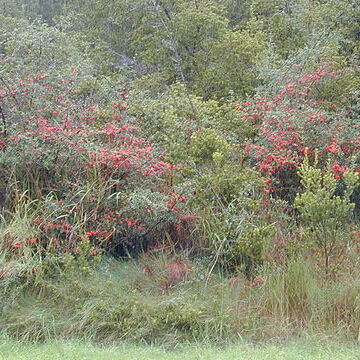Plants 10–30 dm. Stems: thorns sparse to abundant; young twigs rusty-hairy (gray-hairy in 1 variation), glabrescent. Leaves: stipules 3–8 mm; petiole 2–5 mm; blade oblanceolate or obovate, 1.5–6 × 0.5–2.5 cm, base cuneate, margins remotely serrulate or crenulate, often entire proximally, apex obtuse, emarginate, or short-apiculate, surfaces glabrate. Inflorescences 3–4 cm diam. Pedicels 2–8 mm, usually glabrate, rarely sparsely appressed brown-or gray-hairy. Flowers 4–12 mm diam.; hypanthium glabrate, rarely slightly hairy; sepals triangular, 1–1.5 mm, apex obtuse; petals suborbiculate, 3–4 mm, apex rounded. Pomes orange-red to dark red, 3–6 mm diam.; pedicels 2–10 mm. 2n = 34 (China).
An evergreen shrub. It grows 2-3 m high. The small branches are dark brown. They are hairy when young. The short shoots end in a thorn. The leaves are broadly oval and 2-6 cm long by 1-2 cm wide. The flowers are white. The fruit are 5 mm across.

